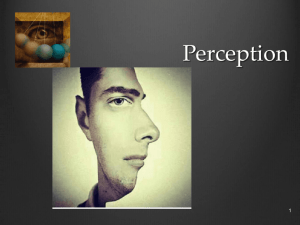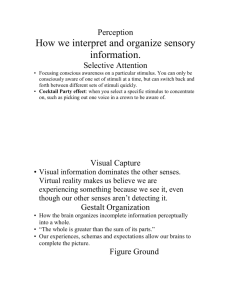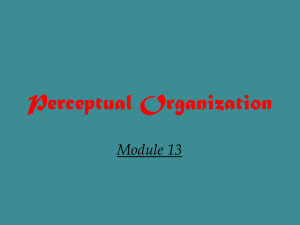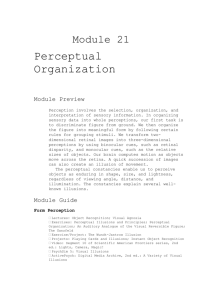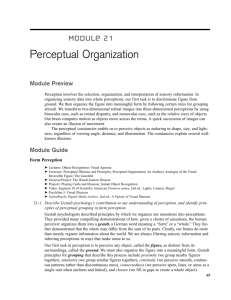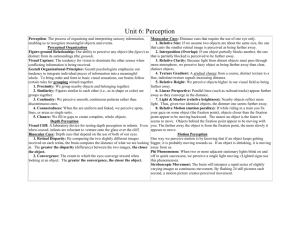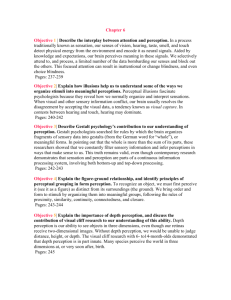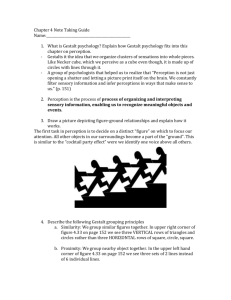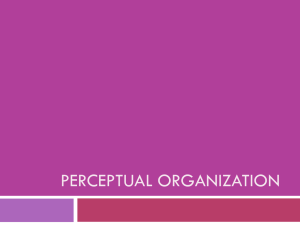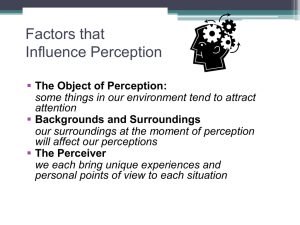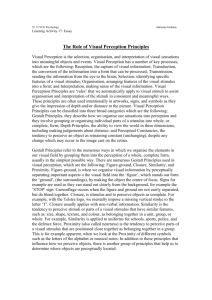164461_SandP_notes_part_2
advertisement
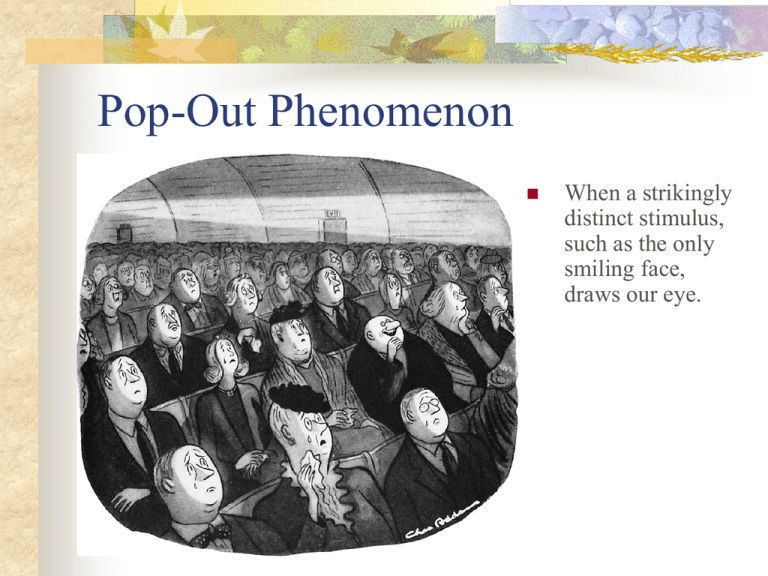
Pop-Out Phenomenon When a strikingly distinct stimulus, such as the only smiling face, draws our eye. Perceptual Sets The tendency for our perceptions to be influenced by expectations or preconceptions. A mental predisposition that greatly influences what we see. Devoted fans to science fiction are more likely to see UFO’s We may fail to notice writing and printing errors. Have also found that emotion, motivation and culture can influence our perception. Is this the letter B or the number 13? The cat sat on the map and licked its whiskers. Perceptual Set What you see in the centre figures depends on the order in which you look at the figures: If you scan from the left, see an old woman If you scan from the right, see a woman’s figure Schemas Through experience we form concepts, or schemas, that organize and interpret unfamiliar information. Especially strong are out schemas for faces. Mona Lisa Form Perception Gestalt principles describe the brain’s organization of sensory building blocks into meaningful units and patterns. They generated laws of perceptual organization such as: Figure and Ground Laws of Grouping Figure and Ground Organization of the visual field into objects (figures) that stand out from their surroundings (ground). Gestalt Laws of Grouping Proximity: Objects that are near each other will be perceived as belonging to a common set. Seeing 3 pair of lines in A. Similarity: Objects that are similar will be perceived as belonging to the same group. Seeing columns of orange and red dots in B. Gestalt Laws of Grouping Continuity: Tendency to perceive stimuli in a unified form. Seeing lines that connect 1 to 2 and 3 to 4 in C, rather than four separate lines. Gestalt Laws of Grouping Closure: Grouping disconnected pieces into a meaningful whole. Seeing a horse in D and “triangle.” Connectedness: The tendency to perceive objects as belonging together when they are positioned together or are moving together. Form Grouping Impossible Doghouse Depth Perception Seeing objects in three dimensions enables us to determine distance. Visual Cliff experiments Gibson and Walker Visual Cliff A laboratory device for testing depth perception in infants and young animals. It suggests that the ability to perceive depth is at least partially innate. Binocular Cues Visual cues to depth or distance that require the use of both eyes. Retinal Disparity: The slight difference in lateral separation between two objects as seen by the left eye and the right eye. Convergence: Turning inward of the eyes, which occurs when they focus on a nearby object. The more the inward strain the closer the object. Monocular Cues Relative Size: The one that casts the smaller retinal shadow is further away. Monocular Clues Interposition: if one object partially blocks another we perceive it as closer. Interposition Monocular Clues Relative Clarity: We perceive hazy objects as farther away than sharp focused ones. Monocular Clues Texture Gradient: A gradual change from a coarse, distinct texture to a fine, indistinct texture signals increasing distance. Monocular Clues Relative Height: We perceive objects higher in our field of vision as further away. Monocular Clues Relative Motion: As we move, objects that are actually stable appear to move. The nearer the object the faster it seems to move. Monocular Clues Linear Perspective: Parallel lines appear to converge with distance. Monocular Clues Light and Shadow: Nearby objects reflect more light into our eyes than more distant objects. Given two identical objects, the dimmer one appears to be farther away. In or Out? Distance Cues The moon just above the horizon typically appears to be unusually large because we perceive it as unusually far away from ourselves. This is a result of distance cues, which make the horizon moon seem farther away. The horizon moon appears to shrink in size if it is viewed through a narrow tube that eliminates the perception of distance cues. This illustrates the importance of context effects. Motion Perception Phi Phenomenon: When two adjacent, stationary lights blink on and off in quick succession, we perceive a single light moving back and forth between them. An illusion of movement Motion Perception Objects traveling towards us grow in size and those moving away shrink in size. The same is true when the observer moves to or from an object. Perceptual Constancy Perceptual constancy enables us to perceive an object as unchanging even though the stimuli we receive from it change. Thus, we can identify things regardless of the angle, distance, and illumination by which we view them. Constant in terms of color, size and shape Shape Constancy Even though these images cast shadows of different shapes, we still see the quarter as round Size Constancy We perceive objects as having a constant size, even while our distance from them varies. Lightness Constancy We perceive an object as having a constant lightness even while its illumination varies. Perceived lightness depends on relative luminance. The amount of light an object reflects relative to its surrounding. The Ames Room The Ames Room The Ames Room A specially-built room that makes people seem to change size as they move around in it The room is not a rectangle, as viewers assume it is A single peephole prevents using binocular depth cues Visual Illusions Illusions are valuable in understanding perception because they are systematic errors. Illusions provide hints about perceptual strategies. In the Muller-Lyer illusion (above) we tend to perceive the line on the right as slightly longer than the one on the left. The Ponzo Illusion Linear perspective provides context Side lines seem to converge Top line seems farther away But the retinal images of the red lines are equal! Fooling the Eye The cats in (a) are the same size The diagonal lines in (b) are parallel You can create a “floating fingertip frankfurter” by holding hands as shown, 5-10” in front of face. Look beyond your fingers to experience the illusion. Hearing:The Psychology of Sound Sound waves are really air molecules being pushed about. Frequency: The length of the sound wave. Pitch Amplitude: The height of the sound wave. Loudness Timbre: Complexity of sound, mixtures of tones Allows us to recognize a friends voice on the phone.
